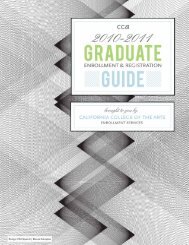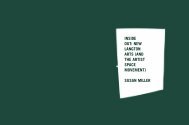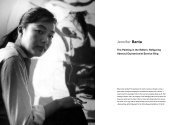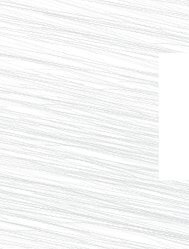Craft in the Expanded Field 138 â 155 Erik Scollon
Craft in the Expanded Field 138 â 155 Erik Scollon
Craft in the Expanded Field 138 â 155 Erik Scollon
- No tags were found...
Create successful ePaper yourself
Turn your PDF publications into a flip-book with our unique Google optimized e-Paper software.
is possible to conceive of actually us<strong>in</strong>g it.To understand this, we can <strong>in</strong>voke <strong>the</strong>work of almost any functional potter work<strong>in</strong>gtoday. To consider <strong>the</strong>ir work with<strong>in</strong> <strong>the</strong>expanded field is to comb<strong>in</strong>e <strong>the</strong> functionaland <strong>the</strong> non-mimetic. If one needed to returnto art discourse, it would be possibleto apply a language of “4D formalism” toobjects of everyday use. Functional potscan produce mean<strong>in</strong>g by play<strong>in</strong>g on colorand shape and balance as sensed with <strong>the</strong>eyes and hands and lips, through use, overtime. In do<strong>in</strong>g so, pottery, like craft, has <strong>the</strong>potential to carve aes<strong>the</strong>tic experiencesout of everyday situations.These four po<strong>in</strong>ts, expand<strong>in</strong>g <strong>the</strong> fieldof ceramics, demonstrate how <strong>the</strong>re can bemany possibilities with<strong>in</strong> a s<strong>in</strong>gle materialchoice. This field splits open <strong>the</strong> reductivedichotomy of vessel/figure usually employed<strong>in</strong> ceramic conversations, and itarticulates a more nuanced version of vesselpractices. Just as Krauss noted that notevery three-dimensional art form can befitted with<strong>in</strong> <strong>the</strong> term “sculpture,” not everyceramic object should exist under <strong>the</strong> term“craft.” If we cont<strong>in</strong>ue to call all of <strong>the</strong>seth<strong>in</strong>gs craft, we will always be struggl<strong>in</strong>gto convey our experiences. Each of <strong>the</strong>sepo<strong>in</strong>ts work<strong>in</strong>g <strong>in</strong> different comb<strong>in</strong>ationsof function and mimesis conta<strong>in</strong>s differentviewer/object relationships.To borrow from Krauss:[This] field provides both for anexpanded but f<strong>in</strong>ite set of relatedpositions for a given artist to occupyand explore, and for an organizationof work that is not dictated by <strong>the</strong>conditions of a particular medium.… It is organized <strong>in</strong>stead through auniverse of terms that are felt to be<strong>in</strong> opposition with<strong>in</strong> a cultural situation… any s<strong>in</strong>gle artist might occupy,successively, any one of thosepositions. 24In <strong>the</strong> context I offer here, <strong>the</strong> specificmean<strong>in</strong>g of those words undoubtedlychanges, but we can see how this textlogically describes <strong>the</strong> way that many ceramicistshave often worked. Althoughdedicated to clay, <strong>the</strong>y easily shift betweenpositions with<strong>in</strong> <strong>the</strong>ir field.How <strong>the</strong>n do we relate <strong>the</strong>se examples<strong>in</strong> ceramics to o<strong>the</strong>r forms of material exploration?No doubt glass, textiles, jewelryand wood could be plugged <strong>in</strong>to this grid<strong>in</strong> a similar fashion, us<strong>in</strong>g comb<strong>in</strong>ations offunction and mimesis as analytical tools.For example, <strong>the</strong>re is sculpture carvedout of wood, as well as furniture as a separateand dist<strong>in</strong>ct category. An axiomaticchair might be an object that referenceschairness, but does not actually <strong>in</strong>vite anaudience to sit upon it. With <strong>the</strong>se po<strong>in</strong>ts<strong>in</strong> m<strong>in</strong>d, we can make a more mean<strong>in</strong>gfuland grounded comparison betweenMiriam Schapiro’s patterned fabric assemblagesthat look like quilts and <strong>the</strong> workof <strong>the</strong> women of Gee’s Bend <strong>in</strong> Alabama,who actually made quilts. Schapiro’s workwas treated like pa<strong>in</strong>ted canvas and dest<strong>in</strong>edfor <strong>the</strong> wall, referenc<strong>in</strong>g a quilt thathad lost its function. The quilts from Gee’sBend might seem formally similar, but <strong>the</strong>ywere <strong>in</strong>tended for real beds, and only laterended up on <strong>the</strong> wall. The former could beseen as an axiomatic example, while <strong>the</strong>latter, I would argue, could be comparedto pottery, <strong>in</strong> that both are functional andnot-mimetic. These same considerations,turn<strong>in</strong>g on function and mimesis, could beextended to glass and metals.If we take this field as a set of operationson cultural terms, we can identifymore specific and mean<strong>in</strong>gful relationshipsbetween <strong>the</strong> diversity of objects thatare all too commonly grouped toge<strong>the</strong>r as“<strong>the</strong> craft materials.” This expanded fieldalleviates pluralism, avoids historicism,and more fully explicates <strong>the</strong> differencesbetween sculptural forms and utilitarianobjects while undo<strong>in</strong>g <strong>the</strong> material essentialismthat is usually assumed of <strong>the</strong>sepractices.A Flexible Model: Compar<strong>in</strong>g <strong>Craft</strong> andSocial PracticeAno<strong>the</strong>r pluralism of practice, variouslydescribed as relational form, relationalaes<strong>the</strong>tics, social practice or socialsculpture, shares an aff<strong>in</strong>ity with “craft”practices. The limited space of this essaycannot do justice to all <strong>the</strong> nuances ofrelational form. But, start<strong>in</strong>g with <strong>the</strong>observation that both modes of work<strong>in</strong>ghave suffered from <strong>the</strong> question “Is thisart?” and that that question seems mostdifficult to avoid when utilitarian functionis very obvious <strong>in</strong> <strong>the</strong> work, we canuse <strong>the</strong> same schematic, with <strong>the</strong> sameterms, function and mimesis, as a way toexplore <strong>the</strong> similarities between craft andsocial practices. Only a few examples willbe exam<strong>in</strong>ed here, but <strong>the</strong>y will also helpto unravel some of <strong>the</strong> differences of practicesand actions that are usually lumpedtoge<strong>the</strong>r under one term.I’d like to beg<strong>in</strong> by compar<strong>in</strong>g and contrast<strong>in</strong>gtwo seem<strong>in</strong>gly similar projects,both deal<strong>in</strong>g with food, <strong>the</strong> gallery as asite, and audience <strong>in</strong>teraction. The firstis Rirkrit Tiravanija’s project Untitled (PadThai), which he performed <strong>in</strong> numerousiterations throughout <strong>the</strong> 1990s. Ra<strong>the</strong>rthan present<strong>in</strong>g a collection of objects tobe viewed, he <strong>in</strong>stead destabilized our expectationsof an art open<strong>in</strong>g by cook<strong>in</strong>gThai curry and serv<strong>in</strong>g it to gallery visitors.In do<strong>in</strong>g so, he took <strong>the</strong> social act of cook<strong>in</strong>gand <strong>the</strong> social act of eat<strong>in</strong>g and claimed“<strong>the</strong> social” as <strong>the</strong> form he chose to sculpt.Like Voulkos’ Rock<strong>in</strong>g Pot, this work is bestunderstood under <strong>the</strong> labels not-functionand not-mimesis. Although Tiravanija wasprovid<strong>in</strong>g food to gallery visitors, arguablya functional service, <strong>the</strong> likelihoodof any of <strong>the</strong> art crowd actually need<strong>in</strong>g<strong>the</strong> meal was slim, and <strong>in</strong> this sense, itsfunctionality was not stable. Or, to speak of150 Sightl<strong>in</strong>es ⁄ <strong>Erik</strong> <strong>Scollon</strong> 151







